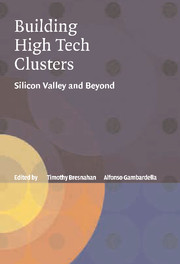Book contents
- Frontmatter
- Contents
- Preface
- List of Contributors
- Building High-Tech Clusters
- 1 Introduction
- 2 Learning the Silicon Valley Way
- 3 Israel's Silicon Wadi
- 4 In the Footsteps of Silicon Valley?
- 5 Agglomeration and Growth
- 6 Clusters, Competition, and “Global Players” in ICT Markets
- 7 Taiwan's Hsinchu Region
- 8 The Role of Government in Regional Technology Development
- 9 Imitating Silicon Valley
- 10 Old-Economy Inputs for New-Economy Outcomes
- Index
- References
2 - Learning the Silicon Valley Way
Published online by Cambridge University Press: 05 June 2012
- Frontmatter
- Contents
- Preface
- List of Contributors
- Building High-Tech Clusters
- 1 Introduction
- 2 Learning the Silicon Valley Way
- 3 Israel's Silicon Wadi
- 4 In the Footsteps of Silicon Valley?
- 5 Agglomeration and Growth
- 6 Clusters, Competition, and “Global Players” in ICT Markets
- 7 Taiwan's Hsinchu Region
- 8 The Role of Government in Regional Technology Development
- 9 Imitating Silicon Valley
- 10 Old-Economy Inputs for New-Economy Outcomes
- Index
- References
Summary
As someone fortunate to have had some success in the business of technology, from time to time journalists and researchers contact me to ask about my experiences in the semiconductor industry here in northern California. Most have sought in some way to define and understand the birth of this place called Silicon Valley. This chapter is, in part, an addendum to and clarification of their efforts. Charting the establishment of this dynamic is fundamentally different than appreciating its operation. We have tried to capture what we feel are the crucial elements of the early history of Silicon Valley through the retelling and reexamination of the experiences of Shockley, Fairchild, and Intel.
We hold that the central element in the history of Silicon Valley is the founding of a previously unknown type of regional, dynamic, high-technology economy. A set of transformations took place in which scientists and engineers of this particular economy learned to organize themselves and their businesses differently – transforming science into business – to take advantage of a significant technological opportunity. These transformations involved learning to build firms and markets in ways unique to high-technology products, and often unique to the particular product at hand. Central to these developments were the size and nature of the technological opportunity that induced it; more than government contracts, university advocacy, or sunny weather, the opportunity defined the creative response.
- Type
- Chapter
- Information
- Building High-Tech ClustersSilicon Valley and Beyond, pp. 7 - 39Publisher: Cambridge University PressPrint publication year: 2004
References
- 64
- Cited by

